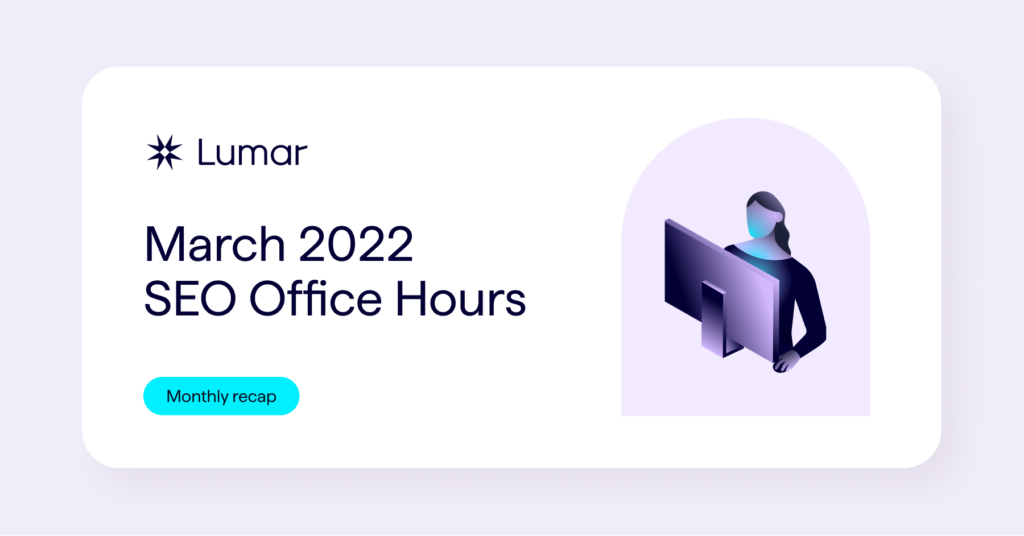We’re back with the latest round-up of the best advice and explainers given in Google’s recent “SEO Office Hours” sessions in March (so far)!
Check out the video clips and summaries below for our top takeaways. As always, you can view our full library of compiled Office Hours notes anytime to dig deeper into the subjects that interest you the most.
Breadcrumb structured data is not a replacement for standard internal linking
Even if a site is marked up with the relevant breadcrumb schema, internal linking continues to be a key focus. URLs included within structured data aren’t treated in the same way as regular internal links, so it’s still critical to link to the most important pages on your site within the HTML.
Skip directly to this part of the session video below:
Multiple instances of product structured data on one page is not recommended
Product structured data is designed to apply to the primary element on a page. A page with multiple products (such as a category page on an eCommerce website) essentially has no primary element, so product structured data is not recommended in these cases.
Here’s the video clip:
Check out our SEO Office Hours Library for more SEO tips relating to structured data and schema markup.
Sites typically won’t get punished for having different content on mobile and desktop
Because Google has switched to mobile-first indexing, this means that Google very rarely crawls the desktop version of a site. Therefore, punishment for differences between the versions is unlikely, as any differences between mobile and desktop probably won’t even be detected. Googlebot does crawl the alternate version of a site from time to time, but this is primarily to confirm the connection between the two, rather than to compare the content.
For more on mobile-first indexing and Google Search penalties, check out our full SEO Office Hours Library.
It’s possible to host sitemap files on a separate domain
One user asked whether they could host their sitemap files externally (perhaps on a separate server or a staging site). John explains that yes, that’s possible as long as the sitemaps are handled correctly. This means either having both domains verified in Google Search Console (GSC), or including a link to the sitemap file within robots.txt. Redirecting the old sitemap to the new location is also a best practice here (note some reporting issues may occur in GSC if the sitemaps are on a different domain, but this shouldn’t impact the functionality of the sitemap file itself).
For more on this topic, see our list of compiled SEO Office Hours notes on sitemaps.
Not all hidden text is considered bad
One user asked whether all hidden text goes against Google’s Webmaster guidelines. John explained that hidden text becomes problematic when it’s there to deceive search engines. Google is generally pretty good at identifying when this is the case, so hidden text that’s not deceptive is generally not a problem. One example given is around accessibility. Content that’s there to aid screen readers (but isn’t visible on the page) is just one way that hidden text can serve a very valid purpose.
For more on this topic, see our compiled notes on hidden content.
The desktop Page Experience roll-out is unlikely to cause immediate or significant ranking changes
As page experience rolls out as a ranking factor on desktop, John is keen to clarify that the weight it holds will largely mirror what’s seen on mobile. If it’s clear that a page is the best result for that query, page experience signals could be downplayed. If there are multiple pages in SERPs that could answer the user’s query and intent equally well, page experience is one of the factors that could be used to distinguish between them and rank one site above another.
It’s not uncommon to see differences across schema validation tools
Users may see a difference in schema validation across tools. This is because the schema.org test is designed to validate all theoretical schemas, whereas the reports in Google Search Console and the Rich Results Test focus only on schema that can have a visible effect on Google search results. It could also be a simple case of the requirements being different across both tools; Google tends to be a little stricter on its requirements than schema.org. If the goal is simply for the marked-up content to appear in Google’s search features, it’s best to follow Google’s own guidelines.
How does Google handle infinite scrolling? Well, it depends…
One user asked whether Googlebot is advanced enough yet to handle infinite scrolling. John explains that pages are rendered by Google using a fairly high viewport. Usually, this means that some amount of infinite scrolling is triggered. However, it all depends on the implementation. The best way to check is to run the page through the Inspection tool to get a clear view of what Google is actually picking up.
There are several possible reasons a page may be crawled but not indexed
John explains that pages appearing as ‘crawled, not indexed’ in GSC should be relatively infrequent. The most common scenarios are when a page is crawled and then Google sees an error code, or the page is crawled and then a noindex tag is found. Alternatively, Google might choose not to index content after it’s crawled if it finds a duplicate of the page elsewhere. Content quality may also play a role, but Google is more likely to avoid crawling pages altogether if they believe there is a clear quality issue on the site.
For more on these topics, see our full library of SEO Office Hours notes on crawling and indexing.








